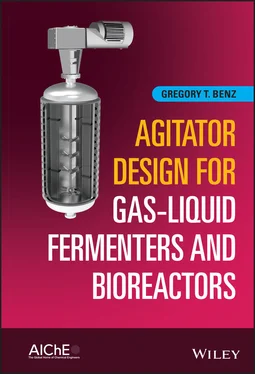1 Cover
2 Title Page
3 Copyright Page
4 Dedication Page
5 Preface
6 Foreword
7 Foreword for Greg Benz
8 1 Purpose of Agitator Design References
9 2 Major Steps in Successful Agitator Design Define Process Results Define Process Conditions Choose Tank Geometry Calculate Equivalent Power/Airflow Combinations for Equal Mass Transfer Rate Choose Minimum Combined Power Choose Shaft Speed; Size Impeller System to Draw Required Gassed Power Decision Point: D/T and Gassing Factors OK? Mechanical Design Decision Point: Is the Mechanical Design Feasible? Repeat to Find Lowest Cost Repeat for Different Aspect Ratios Repeat for Different Process Conditions Finish Summary of Chapter References
10 3 Agitator Fundamentals Agitated Tank Terminology Prime Mover Reducer Shaft Seal Wetted Parts Tank Dimensions How Agitation Parameters Are Calculated Reynolds Number Power Number Pumping Number Dimensionless Blend Time Aeration Number Gassing Factor Nusselt Number Froude Number Prandtl Number Geometric Ratios Baffle Number Dimensionless Hydraulic Force Thrust Number Typical Dimensionless Number Curves A Primer on Rheology Newtonian Model Pseudoplastic or Shear Thinning, Model (Aka Power Law Fluid) Bingham Plastic Herschel–Bulkley Impeller Apparent Viscosity A Bit of Impeller Physics Summary of Chapter References
11 4 Agitator Behavior under Gassed Conditions Flooding k la Method Power Draw Method Visual Flow Pattern Method Effect on Power Draw Holdup Example of Holdup Calculation Holdup “War Story” Variable Gas Flow Operation Mechanical Effects Summary of Chapter References
12 5 Impeller Types Used in Fermenters Impeller Flow Patterns Examples of Axial Flow Impellers Examples of Radial Flow Impellers Examples of Mixed Flow Impellers Examples of Chaos Impellers Summary of Chapter References
13 6 Impeller Systems Why Do We Need a System? Steps to Impeller System Design Choose Number of Impellers Choose Placement of Impellers Choose Type(s) of Impellers Choose Power Split or Distribution Among Impellers Choose D/T and/or Shaft Speed Design to Minimize Shear Damage Sparger Design Summary of Chapter References
14 7 Piloting for Mass Transfer Why Pilot for Mass Transfer Methods for Determining k la Equipment Needed for Scalable Data Experimental Protocol Summary of Chapter References
15 8 Power and Gas Flow Design and OptimizationWhat This Chapter Is about Where We Are in Terms of Design Design with no Data Design with Limited Pilot Data Design with Full Data Choose Minimum Combined Power State of Design Completion Additional Considerations Summary of Chapter References
16 9 Optimizing Operation for Minimum Energy Consumption per BatchPurpose of This Chapter Prerequisite Conceptual Overview Detailed Procedure Practical Design Additional Considerations Summary of Chapter References
17 10 Heat Transfer Surfaces and CalculationsPurpose of This Chapter Design Philosophy Overview of the Problem Heat Sources Cooling Sources Heat Exchange Surface Overview Principle of Heat Transfer Calculation Calculations By Type of Surface Example Problem: Vertical Tube Bundle Additional Consideration: Effect on Power Draw Additional Consideration: Forces on Heat Exchange Surfaces Used as Baffles Additional Consideration: Wall Viscosity Additional Consideration: Effect of Gas External Heat Exchange Loops Summary of Chapter References Further Readings
18 11 Gasses Other Than Air and Liquids Other Than Water General Principle Comments on Some Specific Gasses Economic Factors Disposal Factors Effects of Different Gasses on k la Effects of Different Gasses on Driving Force Operating Condition Effects Constraints on Outlet Concentration Safety Liquids Other Than Water Summary of Chapter References
19 12 Viscous FermentationGeneral Background Sources of Viscosity Viscosity Models for Broths Effect of Viscosity on Power Draw Effect of Viscosity on k la Effect of Viscosity on Holdup Effect of Viscosity on Blend Time Effect of Viscosity on Flooding Caverns Xanthan and Gellan Gums Effect of D/T and No. and Type of Impellers on Results in Xanthan Gum Mycelial Broths Recommendations Summary of Chapter List of Symbols References
20 13 Three Phase Fermentation General Problem Effect on Mass Transfer Effect on Foam Emulsion vs. Suspension Complexity: How to Optimize Operation Summary of Chapter References
21 14 Use of CFD in Fermenter DesignPurpose of This Chapter Basic Theory Methods of Presenting Data Velocity Distribution Cavern Formation Blending Progress Flow Around Coils Bubble Size, k la, Holdup DO Distribution Summary of Chapter References
22 15 Agitator Seal Design ConsiderationsIntroduction Terminology Main Functions of Fermenter Shaft Seals Common Types of Shaft Seals Material Considerations Methods of Lubricating Seals Seal Environmental Control and Seal Support System Seal Life Expectations Special Process Considerations Summary of Chapter Reference
23 16 Fermenter Agitator Mounting MethodsIntroduction Top Entering Methods Bottom Entering Methods Summary of Chapter References
24 17 Mechanical Design of Fermenter AgitatorsIntroduction Simple Example Problem Sample Problem with Steady Bearing Cantilevered Designs Example Problem Units with Steady Bearings Early History Loads Imposed Handle or Isolate Loads? Handle Loads Option 1: Oversized Commercial Gear Drive Handle Loads Option 2: Purpose‐Built Agitator Drive Isolate Loads Option 1: Hollow Quill Integrated Drive with Flexibly Coupled Extension Shaft Isolate Loads Option 2: Outboard Support Bearing Module Important or Useful Mechanical Design Features List of Symbols Greek Letters References
25 18 Sanitary DesignIntroduction Definitions Construction Principles Wetted Parts Construction Methods Bolts and Nuts Steady Bearings Polishing Methods and Measures1: Polishing vs. Burnishing Polishing Methods and Measures2: Lay Polishing Methods and Measures3: Roughness Average Electropolish Passivating Effect on Mechanical Design Summary of Chapter Additional Sources of Information References
26 19 Aspect Ratio Acknowledgment Definition and Illustration of Aspect Ratio What Is the Optimum Aspect Ratio? Effects of Z/T on Cost and Performance at a Given Working Volume Illustrative Problem Number 1 Illustrative Problem Number 2 Illustrative Problem Number 3 Summary of Chapter References
27 20 Vendor Evaluation Product Considerations Gear Drive Ruggedness Design Technology Impeller Selection Shaft Design Reputation with Customers Company Size Years in Business Years Under New Ownership Employee Turnover Vertical Integration R&D Program and Publications Depth of Application Engineering Testing Laboratory ISO Certification (Necessary vs Sufficient) Quality Control Program (Not Lot Sample; 100%) Rep vs Direct Sales (a Good Rep Annoys the Manufacturer) Service Capability Typical Delivery Times and Performance Parts Availability Price (Least Important) Willingness to Work with Consultants Vendor Audit Checklist Summary of Chapter References A.Appendix to Chapter 20
28 21 International PracticesIntroduction North America EU Japan China Summary of Chapter Cultural Resources
29 Afterword
30 Index
31 End User License Agreement
1 Chapter 3 Table 3.1 Metzner–Otto constants.
2 Chapter 5 Table 5.1 Axial flow power and pumping numbers (D/T~0.33) turbulent flow only... Table 5.2 Ungassed power number of the CD‐6 impeller. Table 5.3 Flooding constants of CD‐6. Table 5.4 BT‐6 flooding constants.Table 5.5 Metzner–Otto constants for common impellers.
3 Chapter 6Table 6.1 Quantity of impellers.Table 6.2 Example 6.1 data.Table 6.3 Example 6.2 data.Table 6.4 Sparge ring diameter ratios.
4 Chapter 7Table 7.1 Mass transfer correlation constants.Table 7.2 Range of variables from pilot to full scale.Table 7.3 Full‐scale parameters (typ) using a common k la correlation.Table 7.4 Pilot‐scale parameters to match 200 m 3production parameters.Table 7.5 Pilot‐scale impellers and speed to match 200 m 3production paramete...Table 7.6 Pilot‐scale buying recommendations.Table 7.7 Mass transfer summary.Table 7.8 Example pilot protocol.
Читать дальше












